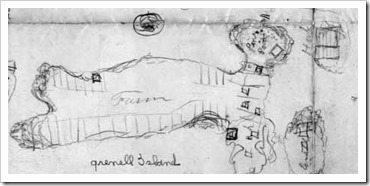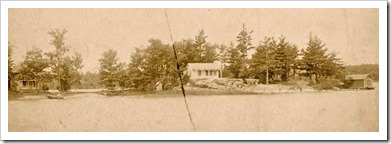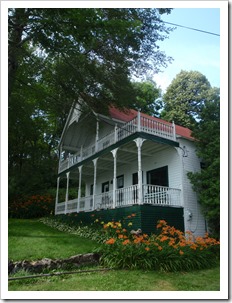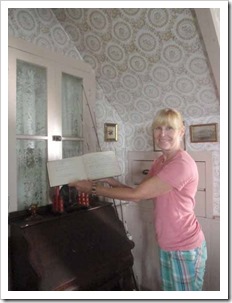We physically leave Grenell Island in the fall, but our hearts never really leave. Every morning at breakfast, husband Gary gives me the Grenell Island weather report. One morning last week, he announced that it was -16 degrees F., with a Windchill factor of –31 F., and snowing. Brrr.
Newcomers to the island are shocked when I tell them that people used to live year ‘round on Grenell, most notably, Sam and Lucy Grenell. The next question is usually, “How that was possible?” It was possible, because like half the population of the United States in the nineteenth century, Sam and Lucy lived on a farm.
|

Uncle Otis’ Map shows a farm in the center of the Island.
|

Early picture of our point with the channel and outhouse
|
When Uncle Otis bought the property in 1880, he made this map of Grenell. As you can clearly see, the middle portion of the island, which is the flattest part, was a farm. I’ve read snippets here and there about cows, chickens and an apple orchard. But, I wouldn’t be surprised if there were a garden, where Sam and Lucy grew corn, beans, and tomatoes, which they canned for use in the winter.
I recently unearthed, in the newspaper archives, an 1875 article about Sam Grenell. It is the only direct quote I have from Sam Grenell and it made me smile:
|
Watertown Times, December 15, 1875
S. B. Grenell, owner of Grenell’s Island, near Clayton, complains that he has had stolen from the island a hand sleigh, a raccoon skin, a pitchfork, a steel shovel and a four-year-old cow. He adds: “Now for God’s sake hold on a while. You make me so nervous and I can’t stand the pressure. If you must steal, steal from someone else and let me rest a spell. The scamps that stole this cow are youngish men, able-bodied; can earn a dollar or a dollar and a half a day. I have sheltered them in a storm and fed them when they were hungry. When they had money they paid me; when they had not it was all the same. Now for them to steal my best cow!”
|
While heralded as an enterprising hotelier in later years, Sam was first and foremost a farmer. I think many Grenellians are surprised to learn that cows once roamed our fair island. That first year that our ancestors, the Pratts, tent-camped on the island, they strung barbed wire to keep Sam’s cows off our little point. Years later, the Pratts dug a channel, not only to keep the cows off the point, but to increase the flow of water in our little cove. I’m sure the location of the outhouse had something to do with the need to increase the flow of water in the cove.
When Sam sold Grenell House to make way for Pullman House, Sam and Lucy moved to the main part of the island and according to Olivia Pratt in her book, “The Story of Grenell, …they choose to build, over near their tenant house and barn.” That was in 1890. Olivia also said they kept the cows and chickens. Lucy sold milk to islanders from a window on the north side of the house. They kept the milk cooled in large containers, tucked under the staircase.
|

Sam and Lucy sold Grenell House and built this cottage near the farm.
|

Sam and Lucy’s great-great-granddaughter, Rae Grenell, stands at the milk window. The milk was stored under the staircase.
|
A note written in the drawer under the staircase, dated May 7th, 1890 reads:
“Old Sam Grenell,” who owned the whole island and had a dairy farm here, built this house. People used to come here for milk, which was given out through the little window under the stairs.
It seems that now that Sam didn’t have a hotel to manage, he could concentrate a little more on his farm.
|
On the St. Lawrence, December 4, 1891
FOR SALE. –A yearling bull, half Ayrshire and half Holstein; best cross-blooded stock there is for dairying or for stock; perfectly kind and will be sold at the low price of $25. Enquire of or address.
S. B. Grenell
Grenell Island Par, N. Y.
|
There were horses on the island at some point, because there are pictures showing wagon tracks that ran from the farm to the bridge that went over to where Grenell House once stood. Grenell wasn’t the only island that had a horse population, as this 1894 article demonstrates:
|
On the St. Lawrence, July 27, 1894
Three stray horses have been found on Grenell Island Park. They evidently swam there from some neighboring island. The owner may have same by applying to S. B. Grenell, Grenell Island, N. Y. and paying charges.
By 1895, there were dozens of cottages on Grenell. The lots that were once a part of the farm were being sold as well. I found an article in an 1895 newspaper that indicated to me that there were no more cows on Grenell.
On the St. Lawrence, March 8, 1895
S. B. Grenell would like to make arrangements with some farmer to supply milk to the cottagers of Grenell Island during the coming summer. Applications should be made to him.
The Grenell’s had lived year-round on Grenell Island since 1860, but around 1887, they left the island in charge of their farm tenant and spent the winter in LaFargeville.
Watertown Herald, October 1, 1887
Mr. and Mrs. S. B. Grenell, Clayton, will spend the winter with his sister, Mrs. J. Kilborn, in LaFargeville.
|
It’s been 125 years since cows grazed on Grenell Island. The farm is gone along with the chickens and horse-drawn wagons. Life is seasonal now. There are several who stay until the snow flies in late November or early December and return before the ice is completely gone, but for the most part, few summer residents are willing to endure the brutal reality of a winter on Grenell island. But, the island pioneers did just that. Endured.
I revel in the stories and the few pictures that we find that can take us to the time when Sam and Lucy Grenell—along with a few cows—eeked out their daily existence on our summer paradise known as Grenell Island.
By Lynn E. McElfresh
Our team member, Lynn McElfresh never ceases to amaze us and this article is just perfect to start the year. This month, January, the islands are covered in snow and mainland residents are coping with blizzards – Lynn has gone back to the 1890s and relates the hardships that island life was like. You can imagine what farming was like.
This marks Lynn’s 108th article. Yes, you read that correctly - 108! What subject could she possibly find to interest our readers… Well she found another one! Do you have family stories about farming in the 1890s – on or off an island. If so, please send them to info@thousandislandslife.com and we will add them to the article.
Thanks again Lynn… You can see all of Lynn’s articles here. (We celebrated her #80 in July, 2015!)